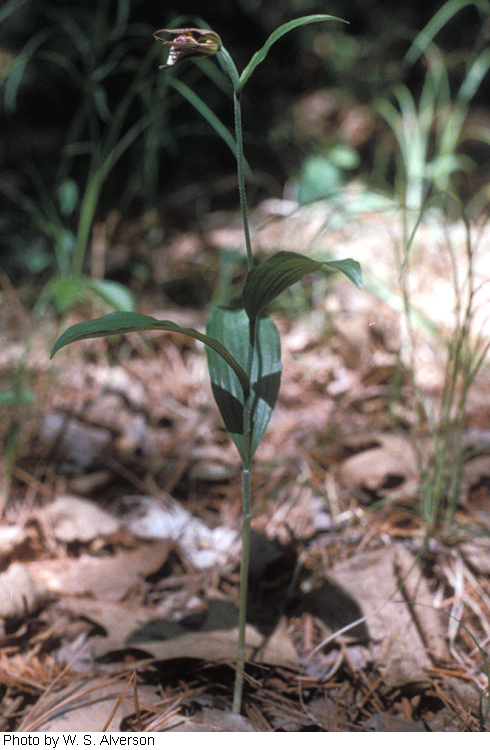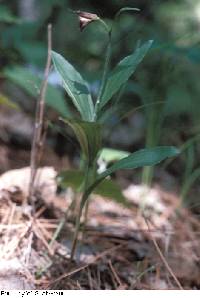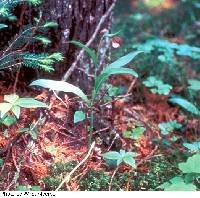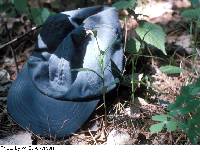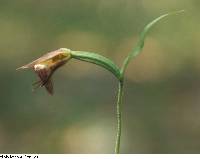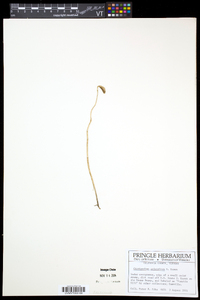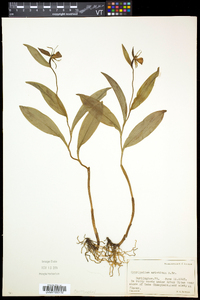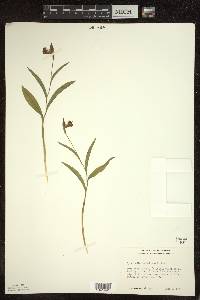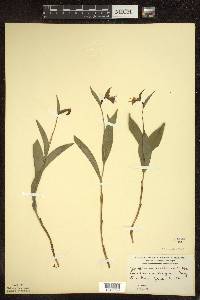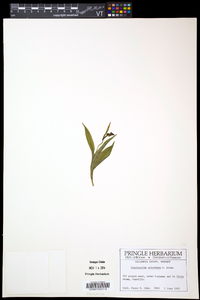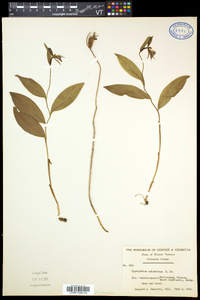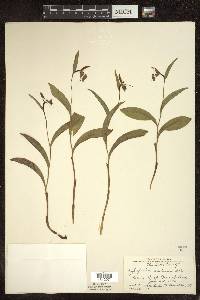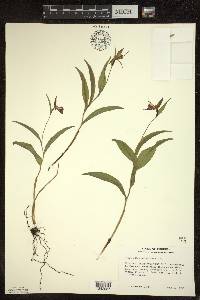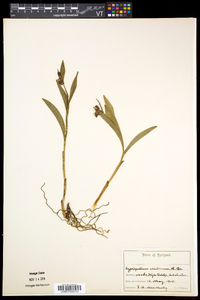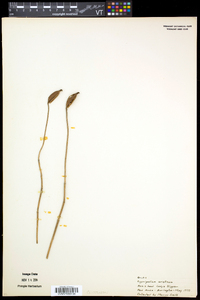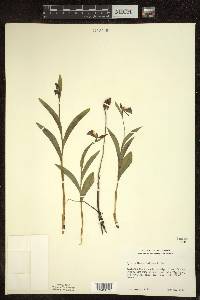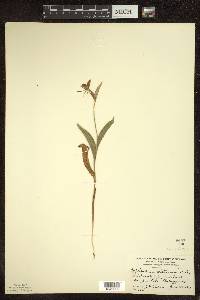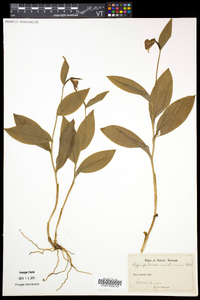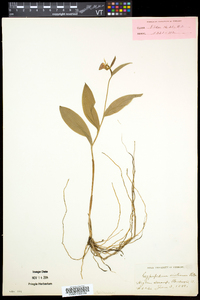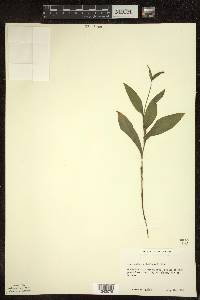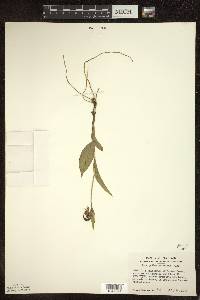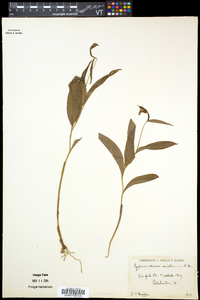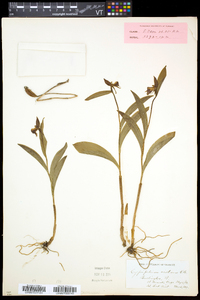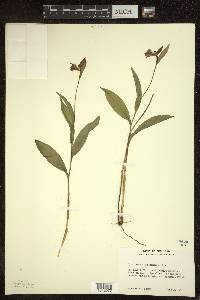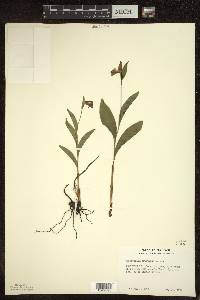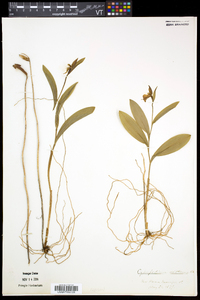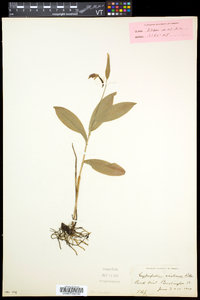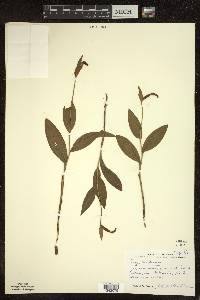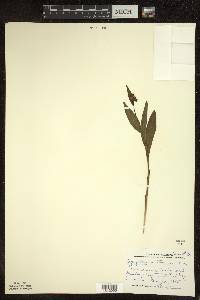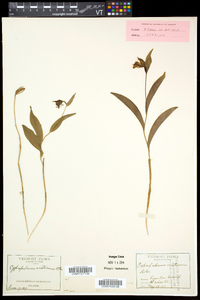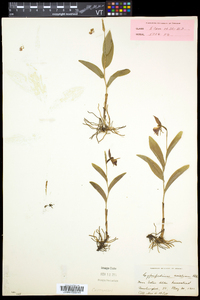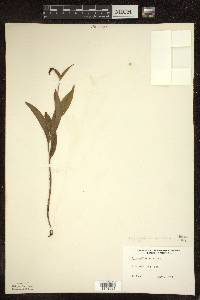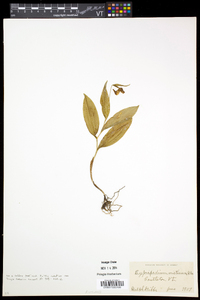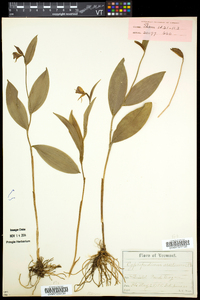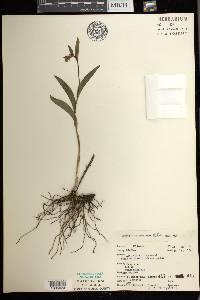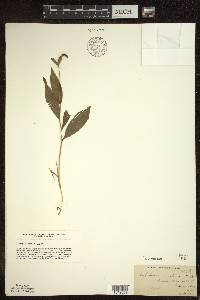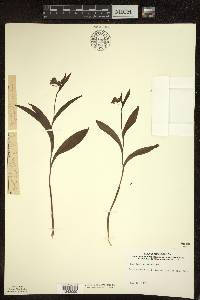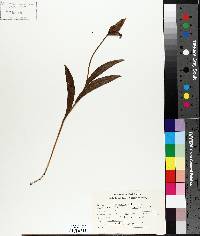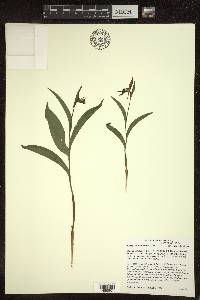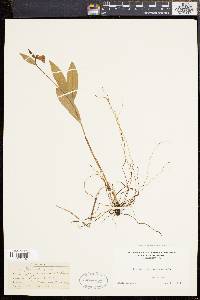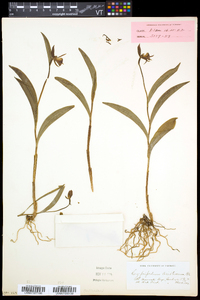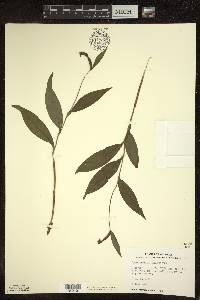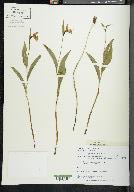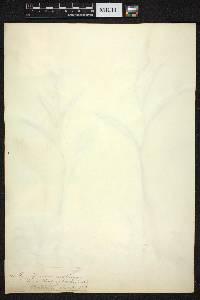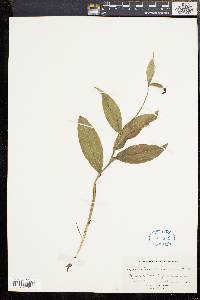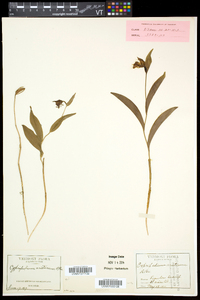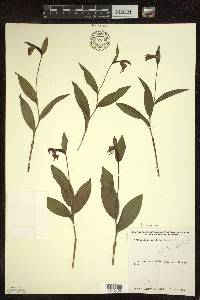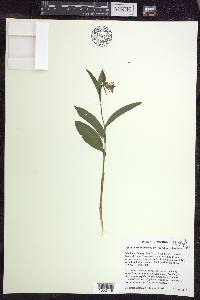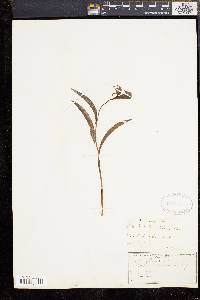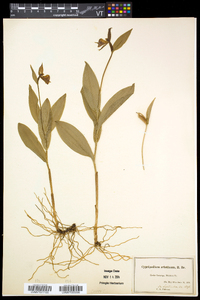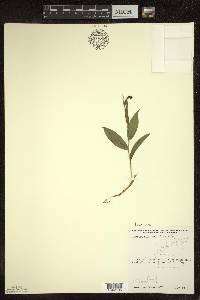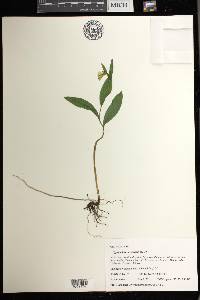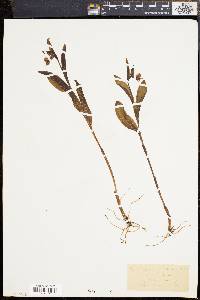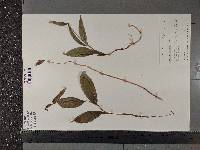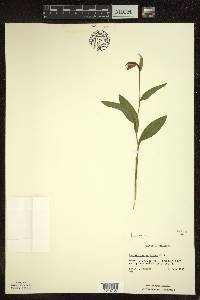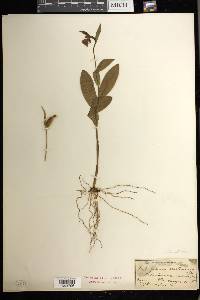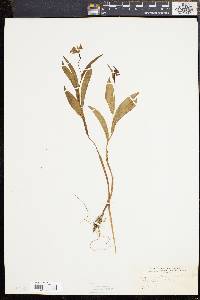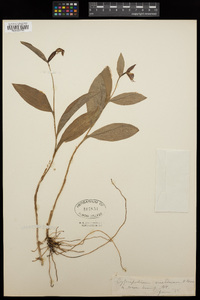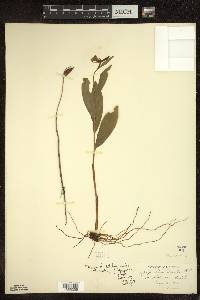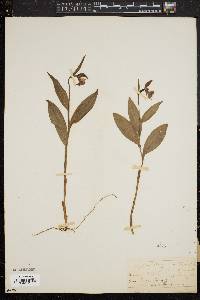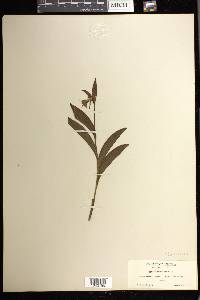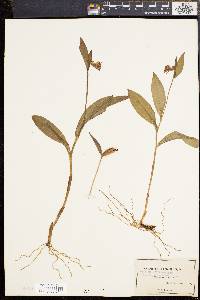Cypripedium arietinum
|
|
|
|
Family: Orchidaceae
Ram-Head Lady's-Slipper
[Criosanthes borealis Raf.] |
Plants erect, 10-35 cm. Leaves 3-4, along middle portion of stem, spiraled to alternate, ascending to spreading; blade narrowly elliptic to ovate-lanceolate or oblong, 5-11 × 1.3-3.5 cm. Flowers usually solitary (rarely 2 in forma biflorum P. M. Brown); sepals green with reddish brown markings; dorsal sepal broadly elliptic to ovate-lanceolate, 15-25 × 5-10 mm; lateral sepals distinct, 12-20 × 1.5-4 mm; petals somewhat spreading, same color as sepals, somewhat spirally twisted, linear- to linear-lanceolate, 11-24 × 1-2 mm; lip white with green apex, usually with extensive reddish reticulations often merging toward apex, adaxially swollen near middle, 10-16 mm, apex abruptly deflected downward, orifice basal, 7-12 mm; staminode suborbicular. 2n = 20. Flowering May--Jun. Dry to moist open coniferous and mixed forests, coniferous-forested fens, beach thickets; mostly 0--400 m; Man., N.S., Ont., Que., Sask.; Conn., Maine, Mass., Mich., Minn., N.H., N.Y., Vt., Wis. Perennial herb 7 - 30 cm tall Stem: one, erect, relatively short (under 30 cm), green, inconspicuously glandular-hairy. Leaves: three to five, ascending to spreading, stalkless, spirally arranged around stem about midway, bluish green, 5 - 11 cm long, 1.3 - 3.5 cm wide, narrowly elliptic to lance-shaped, non-toothed, inconspicuously glandular-hairy, with several obvious legthwise ribs. Inflorescence: of one (rarely two), erect, terminal, fairly stalkless flower closely subtended by a stalkless, erect, green, glandular-hairy, leaf-like, 3 - 5 cm long, 1 - 1.5 cm wide, lance-shaped bract. Sepals: three, fairly spreading, dark red-purple to brownish with green streaks, glandular hairy, and up to 2.5 cm long. The upper sepal is longest (1.5 - 2.5 cm), broadly elliptic to wide lance-shaped (0.5 - 1 cm wide), somewhat helmet-shaped over the staminode and then curving upwards at the long-pointed tip above the lip. Two lateral sepals slightly shorter (1 - 2 cm), narrower (under 0.5 cm), linear, and positioned below and somewhat behind lip. Fruit: a single, more or less ascending, narrowly ellipsoid, glandular-hairy capsule. Root system: of slender, fleshy true roots arising from rhizomes. Flower: maroon and white, showy though small, glandular hairy, bilaterally symmetric with three sepals, two lateral petals, and a lower, highly modified, somewhat hooked, inflated, under 2 cm long, white and maroon lip petal. Unlike other orchids, the reproductive parts of stamens and stigma are not fused into a column above the inferior ovary, but instead at the basal opening of the lip petal there are two separate anthers, one large, sterile, modified staminode, and a lobed stigma above the large, glandular-hairy, inferior ovary. Lateral petals: two, somewhat spreading or curving forward, maroon, 1.1 - 2.4 cm long, 1 - 2 mm wide, linear to narrowly lance-shaped, sparsely glandular-hairy, and sometimes loosely twisted. Lip petal: one, lowermost, white with prominent brown-purple to reddish marks (especially toward the tip), angular-inflated, sparsely glandular-hariy, 1.5 - 2.5 cm long, 1 - 2 cm wide, pouch-like with downward pointed terminal sac. The basal opening of the sac is densly covered with long white hairs, then the lip becomes greatly swollen on the top near the middle where the maroon mottling is obvious, and then narrows a bit into an abruptly deflexed and downward projecting, conic, blunt-pointed, terminal sac extension that is white with green tints at its lowest part. Staminode: one, pale creamy, more or less rounded, and positioned below upper sepal and partially curving into basal opening (orifice) of lip. On the back side of the staminode the two anthers are positioned on each side of the central lobed stigma. Similar species: Cypripedium arietinum is our rarest species of Cypripedium in the Chicago Region and differs from our other species in two major ways: 1) the two lower, lateral sepals are separate, not fused; and 2) the lip petal is fairly angular with its top surface swollen near the middle and then at the apex abruptly deflecting into a conic projection. Flowering: late May to June Habitat and ecology: Extremely rare, in cold bogs or along cool bluffs close to Lake Michigan, but requires cool soils, usually more neutral than acidic, and typically some sort of shade. The only confirmed occurences are in Milwaukee and Racine Counties, WI, although there is supposedly a specimen somewhere collected by Vasey from either McHenry or Kane County, IL (see Swink and Wilhelm 1994). Occurence in the Chicago region: native Notes: This is the most morphologically primitive of our native Cypripedium since it still has separate lateral sepals rather than a fused synsepal below. The flower blooms of this species are quite short-lived. Case (1987) reports that if flowers are not pollinated they may remain open about a week, but once pollinated, certain hormones are released that cause the upper sepal to drop over the basal opening (orifice) of the lip within one to two hours. Etymology: Cypripedium comes from combining the Greek word Kypris for Cypris (Aphrodite), the goddess of love and beauty; and either the Latin word pedis meaning foot, or possibly an orthrographic error for the Greek word pedilon meaning sandal or slipper; together translating roughly to beauty's or lady's foot or slipper, in reference to the inflated lip petal resembling a woman's slipper or shoe. Arietinum derives from the Latin word aries meaning ram, apparently referring to the flower shape resembling a ram's head. Author: The Field Museum Stem slender, 1-4 dm, thinly hairy, with 2-3 sheathing scales below and 3-5 sessile lvs above the middle; lf-blades lanceolate to elliptic, often folded, 5-10 cm, finely ciliate, otherwise glabrous; fl solitary; sep and lateral pet 1.5-2.5 cm, greenish-brown, the upper sep lanceolate, the lower 2 sep separate, linear, the lateral pet lance-linear; lip whitish, strongly red-veined, 1.5-2.5 cm, prolonged downward to form a conical pouch. Moist, usually acid soils in coniferous woods; Que. to Man., s. to Mass., N.Y., Mich. and Minn. May, June. Gleason, Henry A. & Cronquist, Arthur J. 1991. Manual of vascular plants of northeastern United States and adjacent Canada. lxxv + 910 pp. ©The New York Botanical Garden. All rights reserved. Used by permission. |

